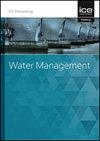用机器学习技术改进翻斗下游冲刷深度预测
IF 1.1
4区 工程技术
Q3 ENGINEERING, CIVIL
Proceedings of the Institution of Civil Engineers-Water Management
Pub Date : 2022-05-05
DOI:10.1680/jwama.20.00089
引用次数: 1
摘要
最常用的耗能结构之一是翻转桶。穿过这些溢洪道的射流,在被抛向空中击中下游河床后,仍然具有高能量,对溢洪道下游产生冲刷作用。因此,准确估计冲刷深度对合理设计主体及相关结构具有重要意义。近年来,利用计算智能来准确估计冲刷深度已被广泛应用。在本研究中,使用梯度增强决策树(GBDT)、额外树(Extra Trees)和随机森林(Random Forest)三种技术估计了最大冲刷深度,并与前人的结果进行了比较。结果表明,GBDT法准确度最高,误差最小,R2=0.992, RMSE=0.231, MAE=0.180。本文章由计算机程序翻译,如有差异,请以英文原文为准。
Improving the Prediction of Scour Depth Downstream of the Flip Bucket with Machine Learning Techniques
One of the most common structures used for energy dissipation is flip buckets. The jet passing through these spillways, after being thrown into the air and hitting the downstream bed, still has high energy causing scour downstream of the spillway. Therefore, accurate estimation of the scour depth is important to the proper design of the main and related structures. In recent years, the use of computational intelligence has been widely used to estimate the scour depth accurately. In this research, the maximum scour depth was estimated using three techniques of Gradient Boosting Decision Tree (GBDT), Extra Trees, and Random Forest (RF) and compared with the previous results. The results indicate that the GBDT method with R2=0.992, RMSE=0.231, and MAE=0.180 has the highest accuracy and lowest error.
求助全文
通过发布文献求助,成功后即可免费获取论文全文。
去求助
来源期刊
CiteScore
2.10
自引率
0.00%
发文量
28
审稿时长
6-12 weeks
期刊介绍:
Water Management publishes papers on all aspects of water treatment, water supply, river, wetland and catchment management, inland waterways and urban regeneration.
Topics covered: applied fluid dynamics and water (including supply, treatment and sewerage) and river engineering; together with the increasingly important fields of wetland and catchment management, groundwater and contaminated land, waterfront development and urban regeneration. The scope also covers hydroinformatics tools, risk and uncertainty methods, as well as environmental, social and economic issues relating to sustainable development.

 求助内容:
求助内容: 应助结果提醒方式:
应助结果提醒方式:


